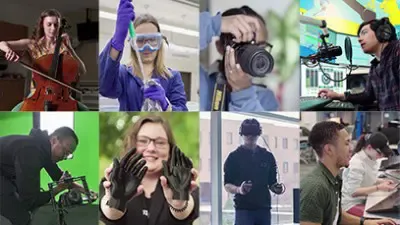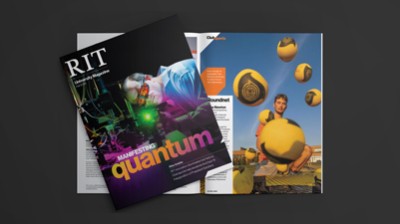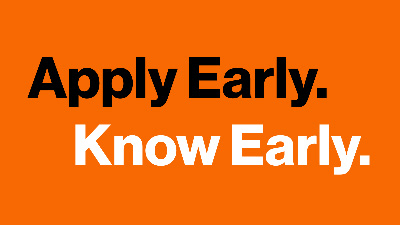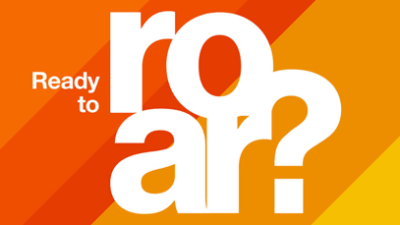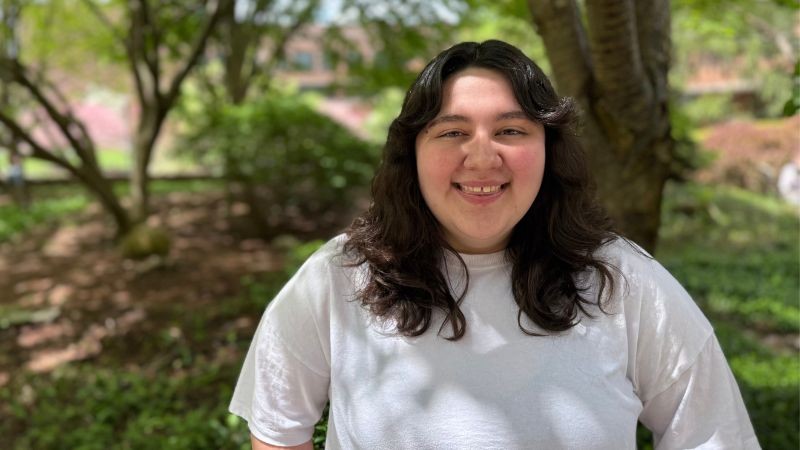Journalism Option - Communication BS

Journalism Option
Communication BS
- RIT /
- Rochester Institute of Technology /
- Academics /
- Journalism Option - Communication BS
In RIT’s journalism option, you’ll master the skills to successfully interview, investigate, write, edit, report, and publish news and featured stories across a range of digital media.
Overview for Journalism Option - Communication BS
Why Pursue the Journalism Option at RIT?
Gain Real-World Experience: A required block of cooperative education means hands-on, full-time paid work experience in the industry.
Dynamic Courses: Gain a deep understanding of news writing, news editing, multi-platform journalism, communication theory, mass communications, law and press ethics, and computer-assisted reporting.
Exciting Capstone Learning Experience: Put your knowledge to work by producing a long-form piece of journalism, a website, and a digital portfolio of selected works.
The journalism option primes you to collect, critically assess, and merge both verbal and visual data to effectively communicate news stories across diverse media channels. Beyond writing and reporting, you'll craft audio and visual content for dissemination across various platforms, positioning you as a skilled and valuable asset for future employers specializing in news reporting and factual narration. This option is part of the communication BS degree
RIT's journalism option benefits from the university's renowned focus on cutting-edge technology while centering on the foundational reporting and writing proficiencies essential for professional journalists. The option prepares you for the dynamic landscape of digital media, where you'll acquire both conceptual understanding and practical expertise essential for success in digital newsrooms. Through a blend of journalism, communication, and relevant professional course work, you'll develop the skills necessary to thrive in the digital media landscape
In RIT's journalism option of the communication degree, you are required to complete one block of cooperative education experience.
Journalism Course Work
You will develop skills through a core of required journalism courses, which cover news writing, news editing, multi-platform journalism, communication theory, mass communications, law and press ethics, and computer-assisted reporting. A professional core of four courses, chosen from RIT’s colleges of Art and Design, Business, or Computing and Information Sciences, introduces you to photojournalism, multimedia, web development, digital entrepreneurship, and building a web business. Journalism electives, free electives, and liberal arts courses complete the curriculum.
Senior Capstone Project
Put your learning to work in a senior capstone project that serves as a culmination of your journalism education. You will produce a project relevant to the journalism industry, such as a long-form piece of journalism, a website, and a digital portfolio of selected works that you created throughout your courses, co-ops, and activities at RIT.
-
Join Us for Accepted Student Open House
Visit campus on March 28 or April 11 to meet faculty, tour campus, and ask your questions.
-
Apply for Fall 2026
First-year students can apply for Early Decision II by Jan. 1 to get an admissions and financial aid assessment by mid-January.
Careers and Cooperative Education
Cooperative Education
What’s different about an RIT education? It’s the career experience you gain by completing cooperative education and internships with top companies in every single industry. You’ll earn more than a degree. You’ll gain real-world career experience that sets you apart. It’s exposure–early and often–to a variety of professional work environments, career paths, and industries.
Co-ops take your knowledge and turn it into know-how. A liberal arts co-op provides hands-on experience that enables you to apply your knowledge in professional settings while you make valuable connections between course work and real-world applications.
You’ll complete one required co-op in the journalism field as part of your degree. Journalism students have completed co-ops at a range of news organizations, companies and not-for-profits where their skills in journalism help tell important stories to wide audiences.
Featured Work and Profiles
-
Four Years and a Full Experience: From career-launching co-ops to clubs and research, this 2025 grad made the most of every moment at RIT
Hailey Fowler began at RIT like so many other first-year college students, slightly shy but super psyched to begin her college journey. At RIT, she soon connected with experiences that gave her an...
Read More about Four Years and a Full Experience: From career-launching co-ops to clubs and research, this 2025 grad made the most of every moment at RIT
Curriculum for 2025-2026 for Journalism Option - Communication BS
Current Students: See Curriculum Requirements
Communication (journalism option), BS degree, typical course sequence
| Course | Sem. Cr. Hrs. | |
|---|---|---|
| First Year | ||
| COMM-101 |
Human Communication (General Education)
An introduction to the theoretical and conceptual underpinnings of oral, visual, and written communication. Introduces basic communication models, the role of language in communication, symbols and symbol making, issues of audience analysis, and the development of different modes of discourse. Also explores the history of communication and introduces students to basic principles and research in communication studies. Lecture 3 (Fall, Spring, Summer).
|
3 |
| COMM-105 |
Foundations of Communication
An introduction to the discipline of communication and the fields of advertising, journalism, and public relations. Topics include: the history and evolution of the discipline, major theories, principles of ethics, methods of research, writing styles, digital portfolio development, professional organizations, and potential careers. Students meet professors in the School, explore opportunities to engage with the professional and academic community beyond the classroom. (This class is restricted to ADVPUB-BS or PTCOMM-BS or COMM-BS or JOURNAL-BS Major students.) Lecture 3 (Fall, Spring).
|
3 |
| COMM-201 |
Public Speaking (General Education)
The public speaking course is designed to equip the student with knowledge of the theories and principles necessary for formal public speaking. Informative and persuasive speeches are the focus with emphasis on organization, evidence, language use, strategy, delivery, and effective use of media aids. Public speaking is generally offered each semester. Lecture 3 (Fall, Spring).
|
3 |
| COMM-202 |
Mass Communications
The history and development of U.S. media, theoretical aspects of mass communications, the composition of media audiences, law and regulation of mass communications and how the media affect and are affected by society are presented. Lecture 3 (Fall, Spring, Summer).
|
3 |
| COMM-271 |
Introduction to Journalism (General Education – Social Perspective)
The course covers the impact/effect of journalism on American society, with an introduction to the history, freedom, technologies, ethics, and functions of the news media. Students will learn how to assess news value, develop news judgment, and analyze news stories. Lecture 3 (Fall).
|
3 |
| COMM-272 |
Reporting and Writing for News Media (General Education)
This course introduces students to the principles and practices of gathering, evaluating, investigating, and presenting information to general audiences. Rights and responsibilities of the press will be analyzed. Although special emphasis will be given to writing and reporting for print publications, other media will be addressed. Special attention will be given to the qualities of writing, especially organization, accuracy, completeness, brevity, and readability. Assignments must conform to Associated Press style. Lecture 3 (Fall).
|
3 |
| MATH-101 |
College Algebra (General Education – Mathematical Perspective A)
This course provides the background for an introductory level, non-trigonometry based calculus course. The topics include a review of the fundamentals of algebra: solutions of linear, fractional, and quadratic equations, functions and their graphs, polynomial, exponential, logarithmic and rational functions, and systems of linear equations. (Prerequisites: Students may not take and receive credit for MATH-101 and MATH-111. See the Math department with any questions.) Lecture 3 (Fall, Spring).
|
3 |
| YOPS-10 |
RIT 365: RIT Connections
RIT 365 students participate in experiential learning opportunities designed to launch them into their career at RIT, support them in making multiple and varied connections across the university, and immerse them in processes of competency development. Students will plan for and reflect on their first-year experiences, receive feedback, and develop a personal plan for future action in order to develop foundational self-awareness and recognize broad-based professional competencies. (This class is restricted to incoming 1st year or global campus students.) Lecture 1 (Fall, Spring).
|
0 |
|
General Education – Artistic Perspective
|
3 | |
|
General Education – Ethical Perspective
|
3 | |
|
General Education – First-Year Writing (WI)
|
3 | |
| Second Year | ||
| COMM-341 |
Visual Communication
This course is an introduction to the study of visual communication. The iconic and symbolic demonstration of visual images used in a variety of media is stressed. The major goal of the course is to examine visual messages as a form of intentional communication that seeks to inform, persuade, and entertain specific target audiences. Lecture 3 (Fall or Spring).
|
3 |
| COMM-342 |
Communication Law and Ethics
This course examines major principles and trends in communication law. The course analyzes a broad range of issues related to the First Amendment, intellectual property, and media regulation. Special attention is paid to discussing the major ethical perspectives and issues surrounding contemporary communication behavior. Lecture 3 (Spring).
|
3 |
| Choose one of the following: |
3
|
|
| COMM-302 |
Interpersonal Communication
Interpersonal communication provides analysis and application of the major theories of interpersonal communication in various situations. The course focuses on perception of self and others, language use, nonverbal communication, and symbolic interaction in the communication of shared meanings in face-to-face and mediated interpersonal relationships. There is a strong focus on both conflict management and intercultural interactions. Lecture 3 (Fall or Spring).
|
|
| COMM-303 |
Small Group Communication
This course provides students with opportunities to engage in small group decision making and problem solving. Students will analyze and evaluate their own experiences and relate them to theories and research from the field of small group communication. Lecture 3 (Fall or Spring).
|
|
| COMM-304 |
Intercultural Communication
Intercultural communication provides an examination of the role of culture in face-to-face interaction. Students may find a basic background in communication, anthropology, or psychology useful. Lecture 3 (Fall or Spring).
|
|
| COMM-343 |
Technology-Mediated Communication
Technology-mediated communication (TMC) was originally defined as a form of electronic written communication. As networking tools advanced, TMC expanded to include new software developments, such as instant messenger and the web. Today, the term technology-mediated communication is used to refer to a wide range of technologies that facilitate both human communication and the interactive sharing of information through computer networks. Through readings, discussions, and observations of online behavior, students will be introduced to TMC terms and theories to further develop their TMC communication and critical thinking skills. Lecture 3 (Spring).
|
3 |
| STAT-145 |
Introduction to Statistics I (General Education – Mathematical Perspective B)
This course introduces statistical methods of extracting meaning from data, and basic inferential statistics. Topics covered include data and data integrity, exploratory data analysis, data visualization, numeric summary measures, the normal distribution, sampling distributions, confidence intervals, and hypothesis testing. The emphasis of the course is on statistical thinking rather than computation. Statistical software is used. (Prerequisites: Any 100 level MATH course, or NMTH-260 or NMTH-272 or NMTH-275 or (NMTH-250 with a C- or better) or a Math Placement Exam score of at least 35.) Lecture 3 (Fall, Spring, Summer).
|
3 |
|
General Education – Immersion 1
|
3 | |
|
General Education – Scientific Principles Perspective
|
3 | |
|
General Education – Global Perspective
|
3 | |
|
Open Elective
|
3 | |
|
Professional Core†
|
3 | |
| Third Year | ||
| COMM-301 |
Theories of Communication
An introduction to human communication theory, including a history of the field and major theories from the intrapersonal, language, interpersonal, small group, public, organizational, mass, visual, and computer-mediated communication contexts. Theories based both in the humanities and the social sciences are covered. This course should be taken during the student's second year. (This class is restricted to ADVPUB-BS or PTCOMM-BS, COMM-BS or JOURNAL-BS Major students.) Lecture 3 (Fall, Spring).
|
3 |
| Choose one of the following: |
3
|
|
| COMM-310 |
Media Production Lab: Project Development, Pitch and Funding
In this tech-forward environment, students will gain hands-on media-production experience and exposure to innovative technologies to enhance their storytelling and media capabilities. Students will develop a project, business plan (where appropriate) and pitch for entry in campus competitions, and will learn how to concisely “sell” their innovative media ideas, and prototype, in a succinct and compelling way to possible funders. Students will also learn how to navigate funding opportunities that are internal to and external to RIT, how to identify gaps in the media-production landscape, and how to make themselves distinct from competitors. At the end of the course, students will have produced, and pitched, their own innovative media project ready for competition. Lec/Lab 3 (Fall or Spring).
|
|
| COMM-450 |
Multiplatform Production & Publishing
This course introduces students to the principles and practices of using multiple mediums to tell stories on multiple platforms, including written text, video, photo, audio, immersive media and other new and evolving forms of media. The course familiarizes students with the tools and techniques of a multiplatform storyteller, for example, digital content strategy, story concept ideation, pre-production, production, post-production and dissemination through new and evolving platforms. Additionally, students explore current examples of multiplatform stories. Lec/Lab 3 (Fall or Spring).
|
|
| COMM-401 |
Quantitative Research Methods
An introduction to the methods and ethics of scientific, scholarly communication research including methods of locating, analyzing, critiquing, and conducting communication research. The course focuses on empirical research methods and leads to the development of a research project proposal suitable for implementation in senior thesis in communication. This course should be taken during the student's third year. (Prerequisites: COMM-301 or equivalent course.) Lecture 3 (Fall, Spring).
|
3 |
| COMM-499 |
Communication Co-op (summer)
One semester of full-time paid work experience in a professional setting related to the communication major. (This class is restricted to ADVPUB-BS or PTCOMM-BS, COMM-BS or JOURNAL-BS Major students.) CO OP (Fall, Spring, Summer).
|
0 |
|
General Education – Natural Science Inquiry Perspective‡
|
3 | |
|
General Education – Immersion 2, 3
|
6 | |
|
Open Electives
|
6 | |
|
Professional Core†
|
6 | |
| Fourth Year | ||
| COMM-402 |
Qualitative Research Methods
Introduction to the methods and ethics of qualitative and critical research. Students are introduced to interviewing, participant observation, naturalistic study, and ethnography. They also develop a disciplined ability for the critical appraisal of public discourse, cultural phenomenon, and designed objects. Both qualitative and critical research methods rely on the researcher's observational, analytic, and critical skills, and seek to understand the behaviors, beliefs, values, attitudes, assumptions, rituals, and symbol systems that characterize relationships between the source, message, media, and audience of specific communication acts. Students will also investigate the processes of rhetorical action. By the end of the course, students will have developed a research proposal suitable for implementation as the senior thesis in communication. This course should be taken during the student's third year. (Prerequisites: COMM-301 or equivalent course.) Lecture 3 (Fall, Spring).
|
3 |
| COMM-497 |
Communication Portfolio
Communication, advertising, and public relations majors create a portfolio comprised of projects, papers, and related professional materials; Journalism majors complete a senior project. Near the end of every semester, the department hosts a portfolio review day when department of communication seniors present their portfolio or project work in a public space for review and comment by faculty, staff, and peers. The presentation constitutes completion of the course. (Prerequisites: At least 4th year student standing in ADVPUB-BS, PTCOMM-BS, COMM-BS or JOURNAL-BS.) Studio (Fall, Spring, Summer).
|
0 |
| COMM-501 |
Senior Thesis in Communication (WI-PR)
A guided research seminar culminating in a major project that brings together the communication students’ communication studies and substantive work in his or her professional core. Focuses on designing, conducting, and completing an independent research project. The progress of each project is shared with the class for discussion and critiques. (Prerequisites: COMM-401 and COMM-402 or equivalent course and student standing in ADVPUB-BS, COMM-BS or PTCOMM-BS program.) Seminar (Fall or Spring).
|
3 |
|
Communication Elective
|
3 | |
|
Professional Core†
|
3 | |
|
General Education – Electives
|
9 | |
|
Journalism Option Courses
|
6 | |
|
Open Elective
|
3 | |
| Total Semester Credit Hours |
120
|
|
Please see General Education Curriculum (GE) for more information.
(WI-PR) Refers to a writing intensive course within the major.
* Please see Wellness Education Requirement for more information. Students completing bachelor's degrees are required to complete two different Wellness courses.
† Professional core may be fulfilled by selecting a 300-level (or higher) course from a discipline outside the liberal arts.
‡ Students will satisfy this requirement by taking either a 3- or 4-credit hour lab science course. If a science course consists of separate lecture and laboratory sections, the student must take both the lecture and lab portions to satisfy the requirement.
Journalism Option Courses
| COMM-223 |
Digital Design in Communication
In an increasingly visual culture, and culture of online user-created content, non-designers are called upon in the professional realm to illustrate their ideas. Graduates entering the workforce will encounter situations where they will benefit from possessing a visual communication sensibility and vocabulary to communicate effectively with a broad range of audiences, including professional designers. Creative approaches to challenges, such as visual thinking, are also shown to improve students’ comprehension and problem-solving abilities. Digital Design in Communication is an opportunity for undergraduates to receive an introduction to principles of visual message design from a critical rhetorical perspective. They will also get the opportunity to apply these principles to a variety of visual products such as advertisements, logos, brochures, resumes, etc. A variety of computer software applications are available to support the research, writing, visualization, and design of messages. Lecture 3 (Fall, Summer).
|
| COMM-240 |
Media, Creativity and Innovation
This foundational course explores how visual creators use new media and technologies for cultural impact and expression in a variety of fields. How have these new innovations merging art and technology impacted contemporary society by combining different languages, including visual, verbal, written and signed? By selecting case studies within the fields of, for example, film, journalism, digital media, games, internet culture, immersive media, students will understand how creative media is shaped by, and engages with, contemporary economic and social issues within the U.S. Lecture 3 (Fall or Spring).
|
| COMM-263 |
Data Journalism
This course covers how to report on, illustrate, find, and analyze records and databases, with emphasis on investigative reporting. Lecture 3 (Spring).
|
| COMM-280 |
Community Journalism
Community Journalism emphasizes the local aspects of news, and teaches students how to identify “community” beyond a region and a neighborhood. A co-taught course with Photojournalism faculty in the College of Art and Design, Community Journalism sharpens students’ reporting skills, and guides them in constructing a reporting project as a complete journalistic package, with visual, artistic and written storytelling components in concert with each other. The final project will be a reported (written) piece with corresponding photographs and multimedia. Lecture 3 (Fall, Spring).
|
| COMM-291 |
Communication for Social Change
The course introduces students to the role of communication, information, and media in social change messaging, particularly in the areas of activism and public advocacy. It takes a critical approach toward understanding the role of communication and communication technologies in the creation and dissemination of messages geared towards social change in a variety of mediated contexts. Students will review relevant theoretical frameworks that commonly inform the study and practice of activism and public advocacy, as well as analyze specific examples and case studies contemporarily, as well as select examples at moments of profound activism since the Civil Rights era of the 20th Century. Students will analyze various forms of activism and examine the role of communication in each. Finally, through the design of a social change communication campaign proposal, students will apply strategic communication approaches that will respond to a social issue that may be local, national or global. Lecture 3 (Fall, Spring).
|
| COMM-356 |
Critical Practice in Social Media
With the advent of virtual communities, smart mobs, and online social networks, questions about the meaning of human communication and how we construct our online and offline personal and professional identities need to be reevaluated. This course explores the relationship between social media and the construction of both individual and social identities as well as best practices for constructing the desired community or identity. Although the course is grounded in theory, it is equally committed to practice, and much of the class discussion and activity takes place in various online spaces. As a practicum, those who complete this course will know how to engage productively in practices such as tweeting, blogging, tagging, etc. and will develop an understanding of how these practices affect their construction of identity and community both personally and on behalf of an organization. Lecture 3 (Fall, Spring).
|
| COMM-370 |
Ethnic Press in the United States
The course examines the role of the ethnic press in the U.S. and the communities they serve, both historically and contemporarily. Students will pay close attention to how the audiences and their relationships to these media sources have shifted over time due to the news consumers’ changing citizenship status, and shifting linguistic practice and cultural histories. While print newspapers will be the primary source focus due to their foundational role within the ethnic press, students will also explore television broadcasts, online and streaming news and their social media counterparts. Students will learn about the historic and ongoing roles these media outlets play with acculturation and social reform, including the fight for racial and religious equity. Financial viability and tensions with the mainstream press will also be explored. Lecture 3 (Fall or Spring).
|
| COMM-374 |
Opinion Media
Opinion Media teaches students how to craft persuasive personal essays, commentary and op-eds, and get them published on news sites, in trade magazines, in newspapers and on influencer blogs. By drawing upon the ethical deployment of evidence, including argument, anecdote and statistical data, student authors will learn how to become influencers and thought leaders through the deployment of the written word and multimedia texts, including writing scripts, and producing video, for their own social media channels. This course is ideally suited for those seeking to sharpen their persuasive writing skills to sell their ideas, vision, expertise and life experience to a targeted media audience. Lecture 3 (Fall).
|
| COMM-390/VISL-390 |
Visual Activism
This course is a history of visual activism from the 20th century to now. The course asks: how is activism represented and disseminated to engage audiences? How is the public sphere in the United States and abroad shaped by visual activist practices? What visual languages are used as forms of documentation, communication, persuasion, and creative expression in the service of social change? We examine a range of examples in their local and global contexts, including counter-culture photography and film, poster graphics, graffiti art, comics and political cartoons, social media, performance, urban interventions, installations, and new media. Lecture 3 (Fall or Spring).
|
Related News
-
September 9, 2025

Winter, Spring, and Summer 2026 RIT Faculty-Led Study Abroad Programs
If you’re considering studying abroad, but aren’t quite sure how it will fit into your schedule, a Faculty-Led Study Abroad Program may be the perfect option. RIT’s College of Liberal Arts faculty are leading a fascinating range of courses during spring and summer 2026.
-
March 28, 2025
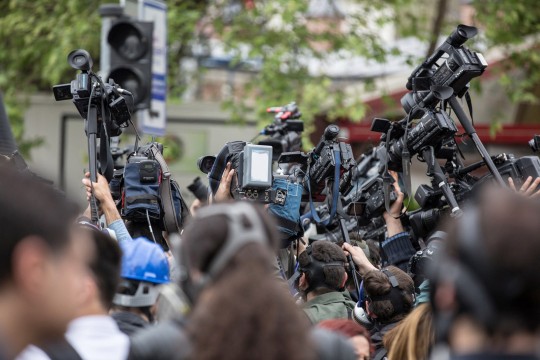
RIT researchers use AI to uncover surprising trends in media coverage of police
A new study from RIT and Carnegie Mellon University experts is challenging a widely held belief about the media—that local news outlets have become more critical of the police in recent years.
Contact
- Heather Roth
- Assistant Director of Recruitment and Retention Outreach
- Dean’s Office
- College of Liberal Arts
- 585‑475‑5456
- hmrgla@rit.edu
School of Communication
